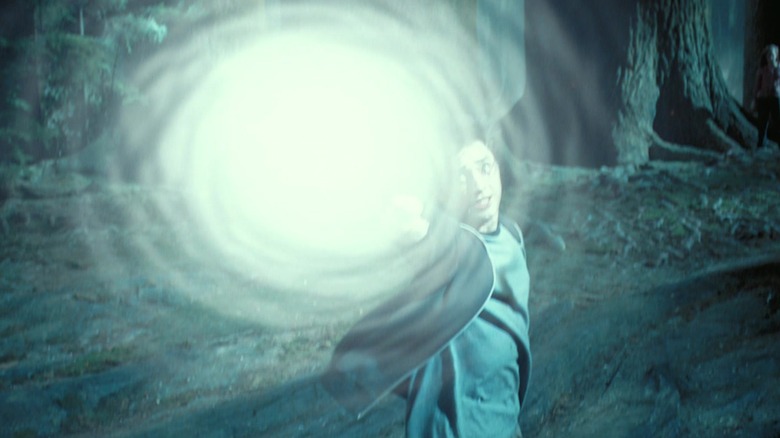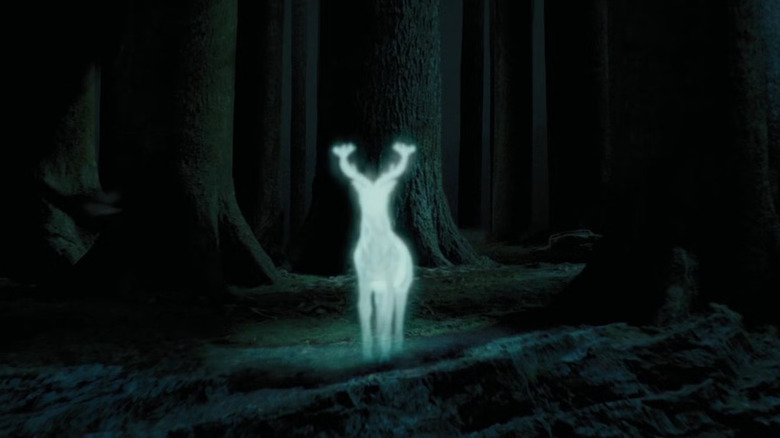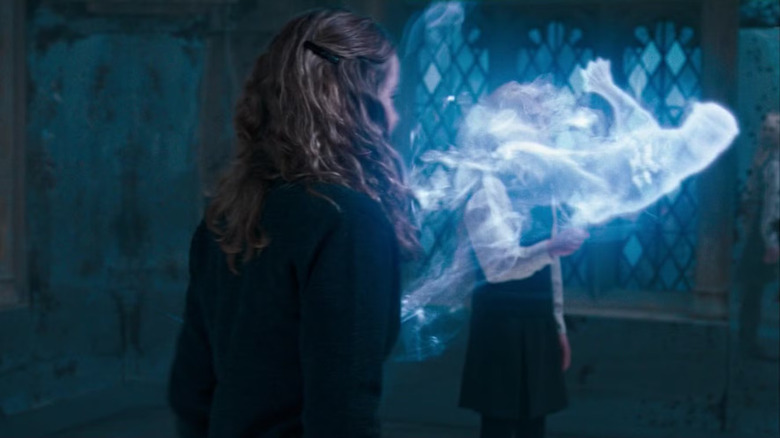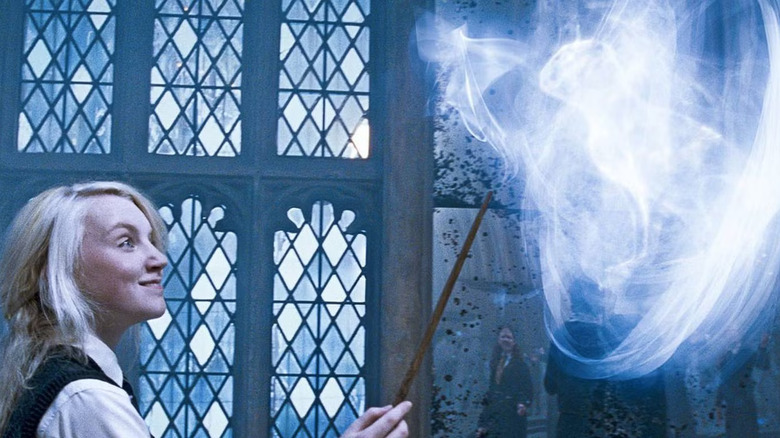Harry Potter: The Patronus Charm Explained
There are a ton of spells in the Wizarding World of "Harry Potter," all of which (obviously) do vastly different things. Some, like "Expelliarmus," will disarm your enemy in battle. Meanwhile, "Accio" summons an object towards you, "Wingardium Leviosa" makes things float, "Alohomora" opens (most) locked doors, and "Avada Kedavra" will kill a grown witch or wizard on the spot. (They're not all nice spells, and I never claimed that they were.) So, what is the Patronus charm (which uses the incantation "Expecto Patronum")?
Alongside all of the spells, there's a whole host of magical creatures in the Wizarding World, and the darkest among them are dementors: soul-sucking, faceless, hooded ghouls who guard the isolated wizard prison Azkaban. The only way to fend off dementors is by using your Patronus, and unlike most spells, the Patronus Charm is completely unique to each witch and wizard who uses it. Take, for example, the eponymous Boy Who Lived, Harry Potter (played in the original film franchise by Daniel Radcliffe). His Patronus, as he learns in the third book and movie, "Harry Potter and the Prisoner of Azkaban," is a stag, which honors his late father James Potter. (James, during his own time at Hogwarts School of Witchcraft and Wizardry, was a secret Animagus and could transform into a stag at will.)
There's something else vitally important about the Patronus Charm, which is that it's so advanced that it doesn't just require magical skill and power — it requires a specific intention when you cast it. (This is a common trait amongst some higher-level spells; in the book version of "Harry Potter and the Goblet of Fire," Hogwarts' Defense Against the Dark Arts professor Alastor "Mad-Eye" Moody tells his students that if one of them tried to cast "Avada Kedavra," he doesn't even think they could make his nose bleed.) When a witch or wizard casts the Patronus Charm, they need to specifically summon happy memories to fuel the spell, because dementors feed on despair; they can only be defeated through joy. Depending on how strong the witch or wizard is, and how happy their memory is, you can either produce a "non-corporeal" Patronus, meaning it's just a puff of silver smoke, or a "corporeal" Patronus, which appears as an animal (like Harry's stag).
So, wait — why does Harry learn such an advanced charm so early in the narrative of the "Harry Potter" saga?
Why does Harry learn to cast a Patronus charm?
Before Harry Potter even begins his third year at Hogwarts in "Prisoner of Azkaban," he receives some unsettling news: A convicted murderer named Sirius Black (played onscreen by Gary Oldman) staged a daring escape from Azkaban and is on the run, and it seems like he's gunning directly for Harry. As a result, the Ministry of Magic sends dementors to guard Hogwarts and its expansive grounds, and when Harry encounters them on the train there, he passes out from how intensely they affect him. Later, Harry learns from that year's Defense Against the Dark Arts professor, Remus Lupin (David Thewlis in the films), that he has such a strong reaction because he witnessed the Dark Lord Voldemort (Ralph Fiennes) murdering his parents when he was just a baby and, therefore, has more inner demons than his friends at school.
Harry, determined to live his life despite the presence of the dementors, insists that he needs to learn to fend them off, so Lupin secretly trains him to cast a Patronus. At first, Harry's Patronus isn't corporeal, but by the end of "Prisoner of Azkaban," there's a whole situation involving a Time-Turner that's honestly too complicated to fully unpack ... and it requires Harry to cast a fully corporeal Patronus. He does just that to save Sirius (who, it turns out, is both innocent and Harry's godfather) from dementors in the Forbidden Forest, and that's when he sees his stag Patronus for the very first time. From that point on, Harry proves to be particularly good at producing a Patronus, even under duress; at the start of "Harry Potter and the Order of the Phoenix," he even saves the life of his cousin, Dudley Dursley (Harry Melling), when two dementors attack the boys in the Muggle town of Little Whinging.
A witch or wizard's Patronus can actually do their bidding
The primary use of the Patronus Charm is to repel dementors, but it actually has another power — it can be used as a mouthpiece or messenger for the witch or wizard who casts it. In "Harry Potter and the Goblet of Fire" (the book, specifically), Albus Dumbledore, the powerful Hogwarts headmaster played in the film by Michael Gambon, uses his phoenix Patronus to communicate with the school's groundskeeper, Rubeus Hagrid (played in the movie by Robbie Coltrane). "He raised his wand into the air and pointed it in the direction of Hagrid's cabin," the book reads. "Harry saw something silvery dart out of it and streak away through the trees like a ghostly bird." Similarly, in the final book, "Harry Potter and the Deathly Hallows," when Harry returns to Hogwarts to find one of Voldemort's last Horcruxes and finally defeat the dark wizard once and for all, Professor Minerva McGonagall, portrayed onscreen by Maggie Smith, creates three messenger Patronuses. "She marched towards the door, and as she did so she raised her wand," the text tells us. "From the tip burst three silver cats with spectacle markings around their eyes. The Patronuses ran sleekly ahead, filling the spiral staircase with silvery lights, as Professor McGonagall, Harry, and Luna [Lovegood, played by Evanna Lynch in the movies] hurried back down."
Then there's the Patronus of Hogwarts' mysterious and taciturn Potions master Severus Snape (Alan Rickman), which is special for a few reasons. First of all, even though Snape moonlights as a Death Eater by Voldemort's side (though he's actually loyal to Dumbledore and, by extension, Harry), it's said that he's the only named Death Eater with a Patronus. Second, Snape's Patronus is a doe in honor of Harry's mother Lily (who he's loved since they were growing up), and throughout "Deathly Hallows," he uses it to secretly communicate with and guide Harry, Hermione, and Ron Weasley (Rupert Grint) as they search for Horcruxes. In the "Deathly Hallows" book, the reveal of Snape's Patronus, which is seen in his memories as the wizard dies, is particularly striking:
"'For him?' shouted Snape. 'Expecto patronum!'
From the tip of his wand burst the silver doe: she landed on the office floor, bounded once across the office and soared out of the window. Dumbledore watched her fly away, and as her silvery glow faded he turned back to Snape, and his eyes were full of tears.
'After all this time?'
'Always,' said Snape."
Here are all the major Patronuses in Harry Potter
We've been over the fact that Harry's Patronus is a stag, Dumbledore's Patronus is a phoenix, and Snape's is a doe ... so, what about the rest of the main characters? Here's a quick rundown of all the Patronuses we see in the books and movies. (If a character isn't on the list, we probably don't know what their Patronus is, though this is also not a completely exhaustive list because these books have a lot of characters.)
- Ron Weasley: Jack Russell terrier
- Hermione Granger: otter
- Minerva McGonagall: cat
- Ginny Weasley: horse
- James and Lily Potter: stag and doe
- Luna Lovegood: hare
- Remus Lupin and Nymphadora Tonks: wolf
- Dolores Umbridge: cat
- Kingsley Shacklebolt: lynx
- Arthur Weasley: weasel
- Cho Chang: swan
- Seamus Finnegan: fox
- Ernie MacMillan: boar
- Aberforth Dumbledore: goat
The "Harry Potter" movies are available to watch on Peacock now.



